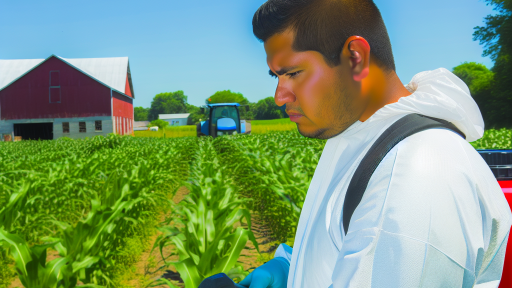Introduction to Biodiversity in Agricultural Landscapes
Biodiversity is essential for the resilience of agricultural systems.
Agricultural landscapes contain not only crops but also various species of plants and animals.
This diversity contributes to ecosystem services such as pollination and pest control.
Moreover, it enhances soil health and increases crop productivity.
Farmers can benefit significantly from maintaining biodiversity on their land.
It can lead to more sustainable farming practices.
The Importance of Biodiversity
Biodiversity plays a critical role in food security.
It provides diverse genetic resources for crop improvement.
Additionally, it helps in adapting to climate change.
Sustainable agricultural practices need a variety of species.
This variety aids in preventing pest outbreaks and diseases.
Challenges to Biodiversity
Modern agricultural practices often reduce biodiversity.
Intensive monoculture farming depletes soil nutrients.
Use of chemical fertilizers and pesticides harms beneficial organisms.
Habitat destruction from land conversion is another major threat.
Transform Your Agribusiness
Unlock your farm's potential with expert advice tailored to your needs. Get actionable steps that drive real results.
Get StartedInvasive species can outcompete native species, leading to biodiversity loss.
Strategies for Conservation
Creating buffer zones around farms can aid in preserving natural habitats.
Integrating agroforestry can enhance species diversity.
Crop rotation and cover cropping improve soil health while supporting biodiversity.
Organic farming practices minimize the use of harmful chemicals.
Farmers can collaborate with local conservation organizations for better outcomes.
The Importance of Biodiversity for Sustainable Agriculture
Enhancing Ecosystem Resilience
Biodiversity strengthens ecosystems within agricultural landscapes.
It enables farms to withstand pests and diseases effectively.
Consequently, diverse ecosystems can recover from environmental stresses.
This resilience results in more stable food production systems.
Supporting Crop and Livestock Production
Different species contribute to improved agricultural output.
Crops with a variety of genetic traits provide better yields.
Likewise, livestock diversity ensures a more robust food supply.
This variety allows farmers to adapt to changing market demands.
Promoting Soil Health
Diverse ecosystems enhance soil fertility and productivity.
Different plants contribute to nutrient cycling within the soil.
Moreover, healthy soils store more carbon, combating climate change.
This fosters sustainable practices that benefit future generations.
Providing Ecosystem Services
Biodiversity offers essential services that support agriculture.
For instance, pollinators play a critical role in crop production.
Additionally, natural pest control reduces the need for chemicals.
These services improve crop quality and farm sustainability.
Fostering Economic Viability
Conserving biodiversity can elevate farm profitability.
Diverse agricultural practices often lead to new market opportunities.
Showcase Your Farming Business
Publish your professional farming services profile on our blog for a one-time fee of $200 and reach a dedicated audience of farmers and agribusiness owners.
Publish Your ProfileThis diversity attracts consumers who value sustainable products.
As a result, farms can thrive within competitive markets.
Key Strategies for Conserving Biodiversity on Farms
Implementing Sustainable Farming Practices
Sustainable farming practices enhance soil health.
They promote diverse crops and reduce chemical use.
Farmers can adopt crop rotation to enrich soil nutrients.
Incorporating cover crops prevents soil erosion.
Additionally, agroforestry fosters biodiversity by integrating trees.
Creating Wildlife Habitats
Establishing hedgerows and buffer strips provides refuge for wildlife.
These areas support beneficial insects and pollinators.
Furthermore, using native plants enhances local ecology.
Water features can attract various species, enriching the ecosystem.
Utilizing Integrated Pest Management
Integrated pest management reduces dependency on chemical pesticides.
This approach employs biological controls and habitat management.
Farmers can introduce natural predators to control pest populations.
Regular monitoring helps identify pest threats early.
Encouraging Community Involvement
Engaging local communities fosters conservation awareness.
Farmers can collaborate with conservation organizations for resources.
Education programs promote sustainable practices among neighbors.
Community-supported agriculture encourages local food production.
Monitoring and Adapting Practices
Regular monitoring of biodiversity helps evaluate conservation efforts.
This data allows farmers to adjust practices as necessary.
Setting biodiversity goals can guide future actions.
Finally, sharing experiences benefits the wider agricultural community.
See Related Content: Creating Habitats to Support Farm Biodiversity
Integrating Agroecological Practices to Enhance Biodiversity
Understanding Agroecology
Agroecology combines agriculture and ecology effectively.
This approach recognizes ecosystems’ complex interactions.
It promotes sustainable farming practices to enhance biodiversity.
Farmers apply ecological principles in their farming systems.
Consequently, agroecology improves resilience against climate change.
Practices that Support Biodiversity
Several agroecological practices enhance biodiversity in agricultural landscapes.
- Crop rotation improves soil health and biodiversity.
- Intercropping promotes a diverse range of species.
- Cover cropping protects soil and prevents erosion.
- Agroforestry integrates trees into farming systems.
- Organic farming reduces chemical inputs that harm biodiversity.
Benefits of Enhancing Biodiversity
Enhancing biodiversity yields numerous benefits for agriculture.
- Diverse ecosystems support pollinators crucial for crop production.
- Healthy soils lead to better crop yields.
- Biodiversity acts as a natural pest control system.
Furthermore, it contributes to making farming systems more resilient.
Implementing Agroecological Approaches
Farmers can adopt agroecological practices gradually.
First, they can assess current practices and identify opportunities.
Next, they should engage with local agricultural communities.
Support from agricultural extension services is vital.
Training programs can share knowledge about sustainable practices.
Case Studies of Successful Implementation
Successful integration of agroecological practices exists worldwide.
In Brazil, farmers have adopted crop rotation techniques.
As a result, they experienced improved soil health and productivity.
Showcase Your Farming Business
Publish your professional farming services profile on our blog for a one-time fee of $200 and reach a dedicated audience of farmers and agribusiness owners.
Publish Your ProfileSimilarly, in India, intercropping has increased yields and biodiversity.
These case studies illustrate the effectiveness of agroecological practices.
Uncover the Details: Reducing Farm Waste with Green Technologies
The Role of Crop Diversity in Supporting Ecosystem Services
Enhancing Soil Health
Crop diversity plays a crucial role in enhancing soil health.
Diverse crops contribute to a richer soil microbiome.
A healthy microbiome improves nutrient availability for plants.
Moreover, different root structures help prevent soil erosion.
Additionally, varied crops can improve soil structure and organic matter content.
Supporting Pollinators and Beneficial Insects
Crop diversity attracts a range of pollinators to agricultural landscapes.
These pollinators help increase crop yields and improve fruit quality.
Furthermore, diverse plant species offer habitats for beneficial insects.
These insects provide natural pest control services.
Consequently, farmers can reduce dependence on chemical pesticides.
Promoting Pest Management
Having a variety of crops can disrupt pest life cycles.
This diversity makes it harder for pests to establish and thrive.
Additionally, companion planting can help deter harmful pests.
For instance, certain flowers can attract beneficial predatory insects.
As a result, crop productivity can significantly improve.
Increasing Resilience to Climate Change
Crop diversity increases agricultural resilience to climatic changes.
Diverse crops can better withstand extreme weather events.
This diversity also helps in managing water resources more effectively.
Moreover, it reduces the risk of total crop failure.
Farmers can adapt their practices to changing climate conditions.
Contributing to Local Economies
Diverse agricultural systems can enhance local food systems.
They support a range of specialty crops that can be marketed locally.
Additionally, diverse crops can create more jobs in rural areas.
Farmers who diversify are often more economically stable.
Consequently, this also boosts community resilience and food security.
Uncover the Details: Implement Crop Rotation for Eco-Friendly Farming
Conservation of Native Species and Their Habitats in Agricultural Areas
The Importance of Native Species
Native species play a critical role in agricultural ecosystems.
They contribute to local biodiversity and ecological stability.
Moreover, native plants provide food and habitat for wildlife.
They promote healthy soil by enhancing nutrient cycling.
Additionally, native species are often more resilient to local pests and diseases.
Strategies for Conservation
Farmers can adopt various strategies to protect native species.
One effective method is to create buffer zones around fields.
Buffer zones can include native vegetation that supports local wildlife.
Another strategy is to use crop rotation and cover cropping.
This practice improves soil health and reduces erosion.
Integrating Conservation into Agriculture
Integrating conservation efforts into agricultural practices is vital.
Showcase Your Farming Business
Publish your professional farming services profile on our blog for a one-time fee of $200 and reach a dedicated audience of farmers and agribusiness owners.
Publish Your ProfileFarmers can participate in local conservation programs.
These programs often provide resources and support for sustainable practices.
Additionally, involving the community in conservation activities raises awareness.
Collaboration between farmers and conservation organizations can yield positive results.
Monitoring and Research
Monitoring native species populations is essential for effective conservation.
Farmers can adopt simple methods to track wildlife presence on their land.
Participating in research initiatives helps understand species needs.
This knowledge allows for more targeted conservation strategies.
Furthermore, sharing data with local organizations strengthens conservation efforts.
Benefits of Conservation Efforts
Conserving native species leads to numerous benefits for agriculture.
Biodiversity enhances pest control through natural predators.
Healthy ecosystems can lead to improved crop yields.
Moreover, conservation practices can increase resilience to climate change.
Ultimately, investing in biodiversity benefits both farmers and the environment.
Discover More: Biodiversity’s Role in Soil Health

Impact of Pesticides and Chemicals on Biodiversity
Negative Effects of Pesticides
Pesticides significantly impact the diversity of species in agricultural landscapes.
Their use leads to direct toxicity in non-target organisms.
Beneficial insects, such as pollinators, suffer severe declines.
Additionally, chemical runoff contaminates nearby water bodies.
This runoff affects aquatic ecosystems and the species within them.
Overall, pesticides disrupt the balance of the ecosystem.
Long-term Consequences
The continuous application of chemicals reduces species resilience.
This decline makes ecosystems more vulnerable to invasive species.
Ecosystem services, such as natural pest control, become compromised.
The loss of genetic diversity also hinders adaptation to environmental changes.
Ultimately, agricultural productivity may decrease over time.
Mitigation Strategies
Integrated Pest Management
Integrated Pest Management (IPM) combines various control methods.
This approach reduces reliance on chemical inputs.
IPM encourages biological control and crop rotation techniques.
Farmers should monitor pest populations regularly.
This monitoring helps inform timely and targeted interventions.
Use of Organic Alternatives
Organic farming practices promote the use of natural pest solutions.
Biological pesticides pose less risk to non-target organisms.
Furthermore, organic fertilizers enhance soil health.
Healthy soils contribute to biodiversity through diverse microbial communities.
Creating Buffer Zones
Establishing buffer zones around fields protects biodiversity.
These zones buffer chemical runoff from entering ecosystems.
Additionally, they serve as habitats for wildlife.
Incorporating native plants in buffer zones supports pollinator populations.
Education and Training
Enhancing farmer education on biodiversity is crucial.
Showcase Your Farming Business
Publish your professional farming services profile on our blog for a one-time fee of $200 and reach a dedicated audience of farmers and agribusiness owners.
Publish Your ProfileWorkshops and resources can inform farmers about best practices.
Communities should promote sustainable agricultural techniques.
Collaboration among farmers can foster shared learning experiences.
Community Engagement and Education for Biodiversity Conservation
Empowering Local Communities
Engaging local communities is vital for successful biodiversity conservation.
Education encourages active participation from residents.
This involvement leads to more sustainable practices in agriculture.
Moreover, local knowledge enhances conservation efforts.
Importance of Education Programs
Education programs raise awareness about biodiversity issues.
These programs help people understand their impact on the environment.
Workshops and seminars foster a sense of responsibility.
Engaging educational materials can make complex concepts accessible.
Building Partnerships with Organizations
Partnerships with local organizations can enhance conservation efforts.
Collaboration brings additional resources and expertise.
Organizations can help facilitate educational initiatives.
Additionally, they can support community-led projects.
Implementing Hands-On Activities
Hands-on activities provide practical experience for community members.
These activities can include clean-up drives and planting events.
Such initiatives create a shared sense of achievement.
Furthermore, they strengthen the community’s connection to nature.
Utilizing Technology for Better Outreach
Technology can significantly enhance education outreach efforts.
Social media platforms can spread awareness quickly.
Webinars and online courses reach broader audiences.
Engaging digital content can spark interest and participation.
Measuring Success and Continuous Improvement
Evaluating educational programs is crucial for ongoing success.
Surveys and feedback can identify areas for improvement.
Setting measurable goals can guide future initiatives.
Consistent adjustments will help maintain effectiveness over time.
Case Studies of Successful Biodiversity Conservation in Agriculture
Integrating Biodiversity on Farms
Farmers can enhance biodiversity by integrating native plants into their fields.
This strategy creates habitats for beneficial insects and wildlife.
For instance, the Johnson family farm in Ohio uses cover crops effectively.
Cover crops boost soil health and attract pollinators.
As a result, their yields improved significantly over three years.
Creating Wildlife Corridors
Wildlife corridors connect different habitats within agricultural landscapes.
These corridors enable species movement and genetic exchange.
The Green Acres project in California illustrates this concept perfectly.
Landowners collaborated to establish corridors alongside fields.
Consequently, local bird populations have increased by 30%.
Organic Farming Practices
Organic farming promotes biodiversity through natural pest control.
For example, the Garcia Organic Farm in Texas employs beneficial insects.
They use ladybugs and lacewings to target crop pests effectively.
Showcase Your Farming Business
Publish your professional farming services profile on our blog for a one-time fee of $200 and reach a dedicated audience of farmers and agribusiness owners.
Publish Your ProfileThis method minimizes pesticide use while boosting ecosystem health.
The farm experienced a noticeable increase in beneficial insect populations.
Agroforestry Systems
Agroforestry systems combine agriculture and forestry practices.
These systems provide diverse habitats for a variety of species.
The Smith Agroforestry Project in Oregon is a notable case.
Farmers planted trees alongside crops to improve biodiversity.
As a result, soil erosion decreased, and wildlife flourished.
Community-Based Conservation Efforts
Community engagement is crucial for effective biodiversity conservation.
The Farm Collaborative in Colorado brings farmers together.
They share resources and knowledge on sustainable practices.
Through workshops, they promote the importance of biodiversity.
This collaborative approach enhances overall ecosystem resilience.
Utilizing Technology for Better Management
Modern technology plays an essential role in biodiversity conservation.
Farmers now use drones and data analytics to monitor biodiversity.
The AgriTech Solutions initiative in Illinois exemplifies this trend.
They provide farmers with insights to optimize land use.
As a result, farmers can tailor their practices to support local wildlife.
Additional Resources
Impact of Sustainable Agriculture and Farming Practices
Biodiversity conservation and agricultural sustainability: towards a …




